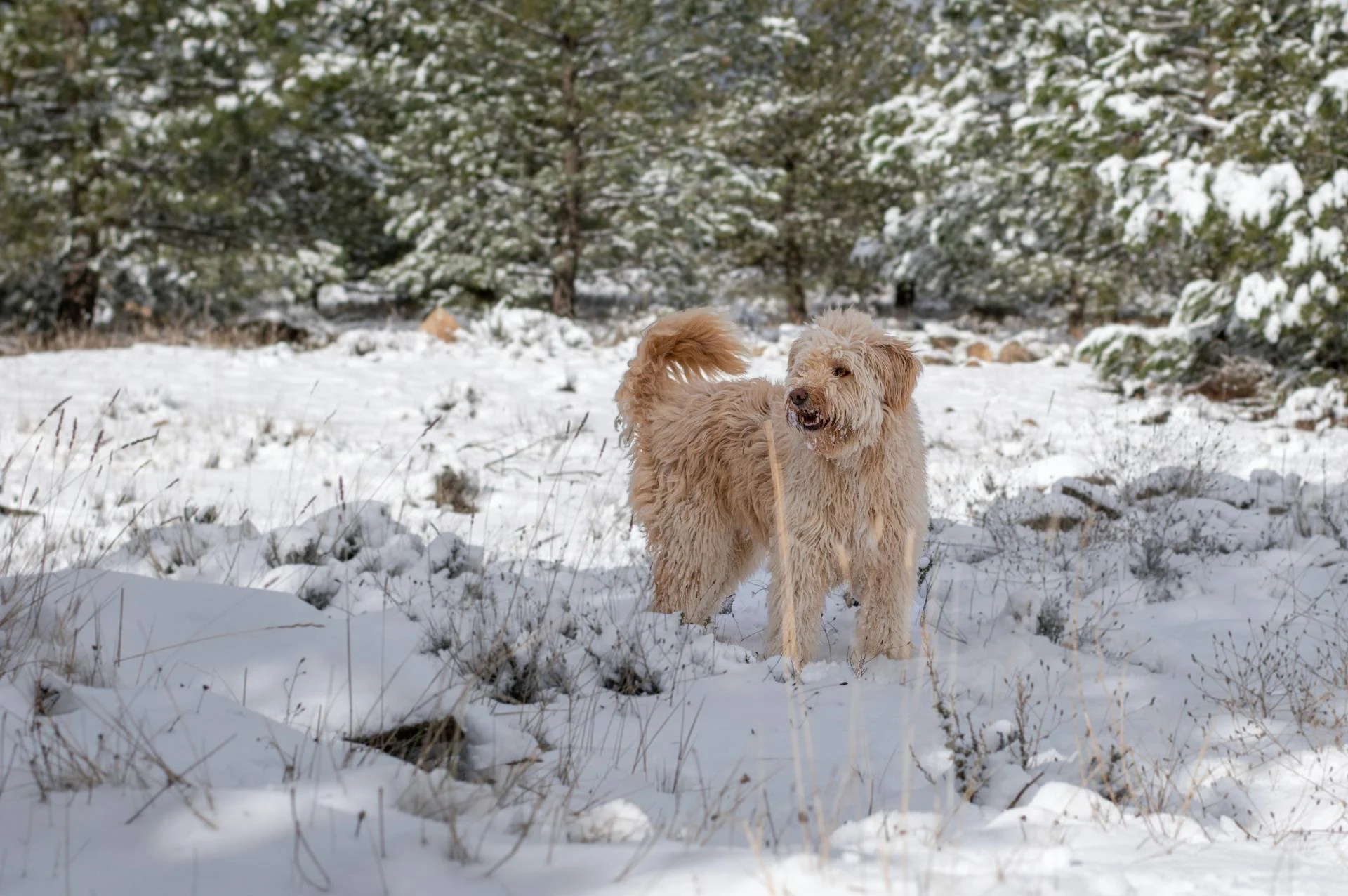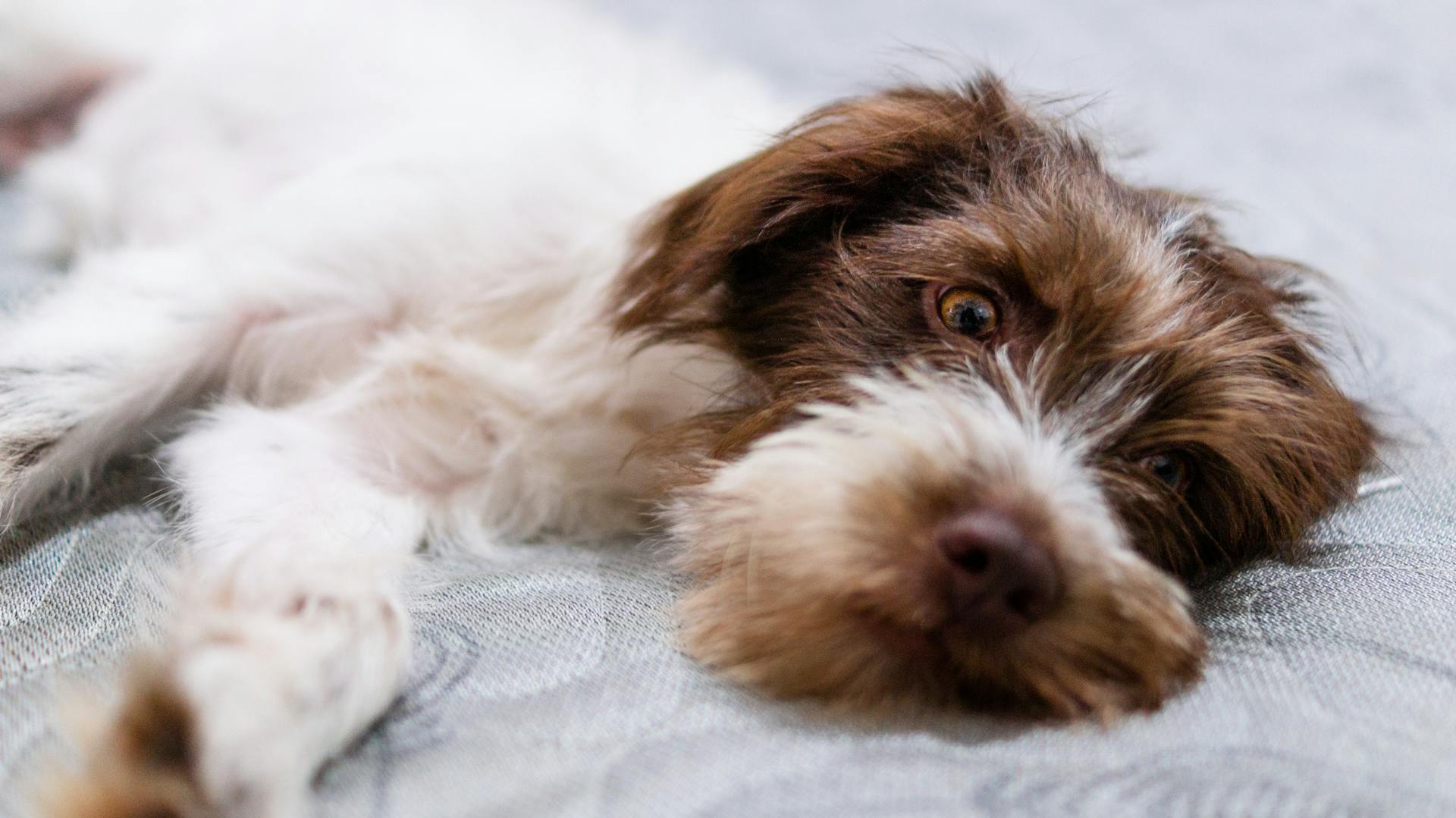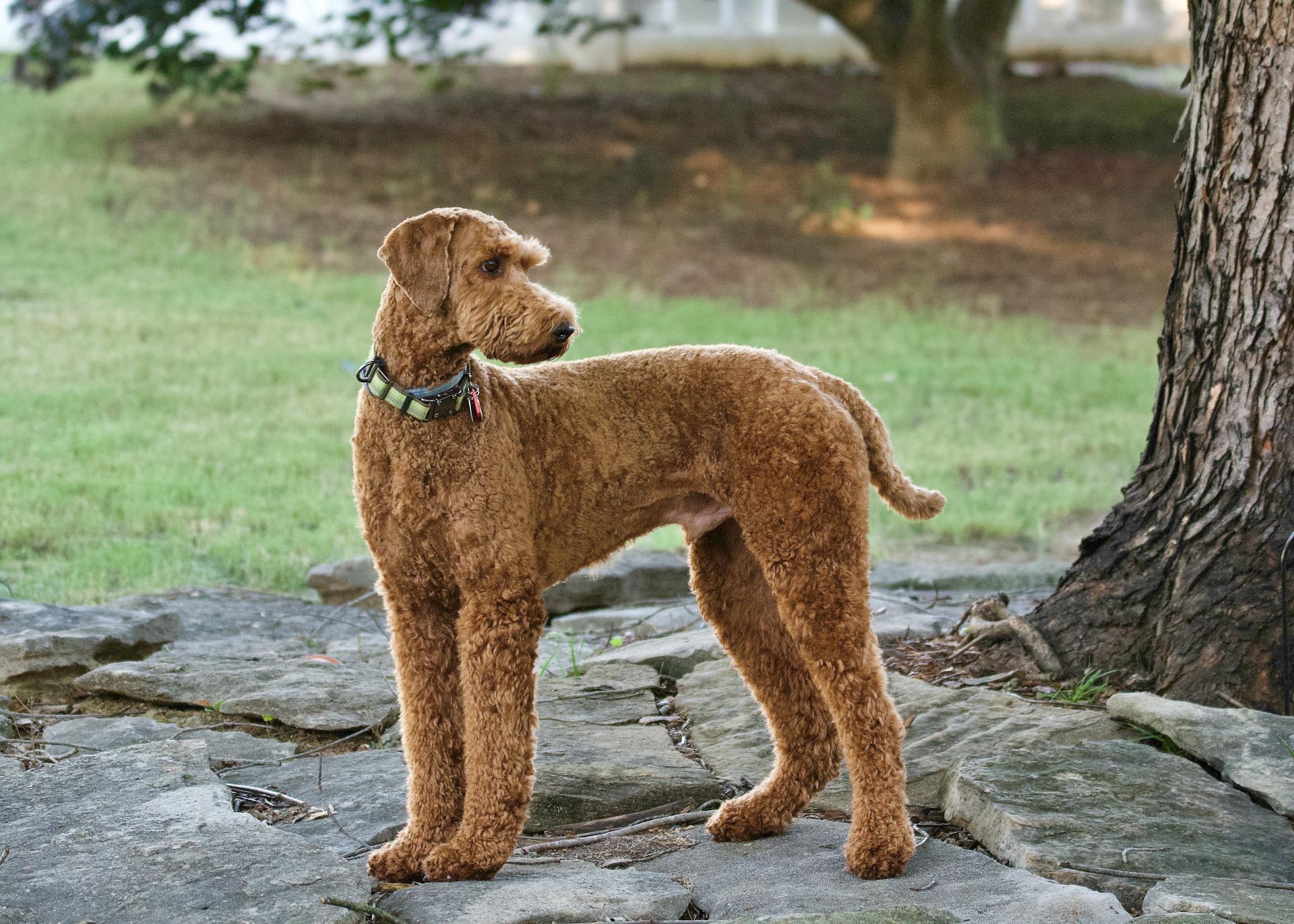
Labradoodles and Standard Poodles are two popular breeds that often get confused with each other. However, they have distinct differences in terms of their origins and purpose.
The Labradoodle was originally bred in the 1980s to be a low-shedding guide dog. This was achieved by crossing a Labrador Retriever with a Poodle.
In contrast, the Standard Poodle has been a beloved breed for centuries, known for its intelligence and athletic ability. Standard Poodles are often used in obedience and agility competitions.
Their grooming needs are also quite different. Standard Poodles require regular grooming to prevent matting and tangling of their fur, whereas Labradoodles often have a low-shedding coat that requires less maintenance.
Recommended read: Do Labradoodles Need Grooming
Labradoodle Temperament
Labradoodles are known for their friendly and outgoing personalities, similar to that of a small child. They're playful, busy, eager to please, and curious about the world around them.
One of the most notable characteristics of Labradoodles is their love for people. They're amazing with any age range, and can even thrive in households with young children, as long as their boisterous play is kept in check.
Labradoodles are also naturally curious, which can sometimes get them into trouble if they become bored. To prevent this, it's essential to provide them with plenty of mental stimulation, such as puzzle toys or games.
Here are some key traits to consider when thinking about bringing a Labradoodle into your family:
- Easy-going and keen to be friends with everyone
- Suitable for households with other pets and young children
- Can be vocal when they need attention or are stressed, anxious, or bored
- Ideal for confident first-time owners or families with some dog experience
- Naturally curious and can be destructive if bored
- Can tolerate being alone for short periods, but may suffer from separation anxiety
It's worth noting that Labradoodles can reflect the energy levels of their owner, but they're still descendants of sporting dogs who like to stay active. Whether it's a long walk or a game in the yard, a Labradoodle will be happiest with any activity they can do with you.
Training & Care
Labradoodles are highly intelligent dogs that respond well to consistency and positive reinforcement. They're extremely motivated by food, so incorporating treats into your training plan can be a great way to keep them engaged.
Labradoodles need at least an hour of physical activity each day, and they love to swim, making it a great low-impact exercise option for senior dogs or those with joint problems. They also enjoy agility courses and mental stimulation, such as puzzle feeders and "magic tricks" like hiding treats under cups.
To establish a positive relationship with your Labradoodle, it's essential to be patient and avoid yelling or aggression. Instead, focus on building trust by rewarding good behavior and setting clear expectations. Here's a quick rundown of daily exercise and training needs:
By following these tips and being committed to your Labradoodle's training, you can help them become a well-behaved and loving companion.
Training Your Standard Poodle
Training your Standard Poodle requires patience, consistency, and positive reinforcement. They are highly intelligent dogs that respond well to rewards, especially food.
Labradoodles, a breed that combines Labrador and Poodle, also thrive on positive reinforcement and are extremely motivated by food. This suggests that Standard Poodles may have similar traits.
To establish a positive relationship with your Standard Poodle, it's essential to be patient and avoid aggression. Yelling or making threatening gestures can be misinterpreted by your dog, leading to undesirable behaviors.
Labradoodles, for instance, don't respond well to aggression, so it's crucial to approach training with kindness and understanding.
Intriguing read: Standard Poodle Dog Food
One way to establish yourself as the leader of the pack is to set clear expectations and boundaries. This can be achieved by creating a schedule for your dog and sticking to it.
Labradoodles benefit from a schedule, which helps ease anxiety and ensures they know what to expect. Similarly, Standard Poodles may appreciate a predictable routine.
Teaching your Standard Poodle to wait patiently is an essential skill that can prevent undesirable behaviors like jumping. To accomplish this, show your dog a treat and ask it to sit and wait. If it runs towards you or jumps up, take the treat away and only reward it when it sits calmly.
Labradoodles can learn to wait patiently with consistent training, and Standard Poodles may respond similarly.
Here's a quick rundown of what you can expect from Standard Poodle training:
- Highly intelligent and responsive to rewards
- May benefit from a predictable schedule and clear expectations
- Requires patience and positive reinforcement
- Can learn to wait patiently with consistent training
Care
Labradoodles are considered smart dogs and will pick up what you're teaching very quickly. They may even understand some commands within the first day. Daily training doesn't take too long, with three or four 10-minute sessions each day recommended to accommodate their short attention spans.
Regular grooming is essential for Labradoodles, and it's probably best to outsource it. They need regular trims every six weeks, regardless of their generation. This will keep their hair from getting matted or uncomfortable.
Labradoodles do enjoy their activity, but they'll spend just as much time lounging around to relax. Three to four walks a day will suffice, and some playtime in the yard or at the park will help your dog immensely.
Grooming
Grooming is an essential part of labradoodle care. Labradoodles need regular grooming to prevent matting and keep their coat healthy.
Labradoodles come in three coat varieties: hair coat, wool coat, and fleece coat. Each coat type has different grooming requirements. Brushing twice a week is a good starting point, with trips to the groomer every two to four years.
Labradoodles are bred to be hypoallergenic, making them a great option for people with allergies. They shed less than other dogs, but regular grooming is still necessary.
Readers also liked: Standard Poodle Grooming Styles
A standard labradoodle grooming routine includes trimming nails, cleaning ears, brushing teeth, and brushing the coat. Trimming nails correctly ensures your pet can walk comfortably. If you ignore your dog's nails, they may rip.
Cleaning your labradoodle's ears helps prevent infections. Brushing teeth regularly prevents gum disease and associated issues. You should brush your labradoodle's teeth as often as possible.
Labradoodles can develop matting in their coat, especially in the chest, neck, and armpits. Check your labradoodle's coat two to three times a week for matting. Use a slick brush or a bristle brush to gently work through knots and tangles.
Labradoodle puppies need regular brushing to prevent matting and keep their coat healthy. They may not grow their adult coat until they are approximately a year old. Use scissors with rounded tips to trim your puppy's hair, especially on the face.
Here are some grooming tools you may find useful:
- Slick brush: A wide-based brush with fine bristles for working through knots and tangles.
- Bristle brush: A gentle brush for your labradoodle's skin.
- Pin brush: A quick brush for after playtime.
- Blunt-tipped scissors: For trimming hair around your labradoodle's eyes.
Remember to provide detailed grooming instructions to your groomer if you decide to take your labradoodle to a professional. This will ensure your dog maintains its trademark Labradoodle appearance.
A different take: Labradoodle More Labrador than Poodle
Appearance
Labradoodles can come in a wide range of colors, including black, white, cream, red, chocolate, and more.
The most common colors for Labradoodles are black, brown, cream, caramel, chocolate, liver, gold, yellow, red, and white.
Labradoodles can have a medium to long coat that needs to be brushed frequently.
Standard Labradoodles typically weigh between 50-75 pounds, with the female dogs slightly smaller than the males.
Labradoodles can grow to be around 20-25 inches tall.
The F1b and F2 generations of Labradoodles are often considered better options for people with allergies, as they tend to shed less.
Recommended read: Red Standard Poodle Puppy
Health
Labradoodles are generally a healthy breed, but they can inherit health problems from their parent breeds. They can suffer from hip and elbow dysplasia, just like Labs.
Regular testing is crucial to identify genetic abnormalities in Labradoodles. A good breeder will conduct DNA tests on the puppy's parents and have their hips and elbows tested and certified by the Orthopedic Foundation for Animals.
Labradoodles can also be prone to myopathies, diseases that damage muscles, and exercise-induced collapse. Keeping a close eye on their diet and exercise routine can help prevent these issues.
For more insights, see: Standard Poodle Exercise Needs
Health Issues in Labradoodles
Labradoodles are a relatively healthy breed, but they can inherit health issues from their parent breeds. They may be prone to hip and elbow dysplasia, just like Labrador Retrievers.
It's essential to find a breeder who conducts DNA tests on the puppy's parents to identify any genetic abnormalities. This is a prerequisite for ensuring the health of your Labradoodle.
Labradoodles may also be susceptible to myopathies, diseases that damage muscles, and exercise-induced collapse. These conditions can be serious, so it's crucial to be aware of the risks.
Labrador Retrievers are known to overeat, and Labradoodles may follow suit. Be sure to keep an eye on your Labradoodle's weight and prevent overeating to maintain their overall health.
Here's an interesting read: Standard Poodle Health Concerns
Health Issues in Standard Poodles
Standard Poodles are prone to eye problems, with issues like cataracts and progressive retinal atrophy affecting many individuals.
The risk of eye problems increases with age, with most cases developing after the age of 10.
For more insights, see: Standard Poodle Back Leg Problems
Hip dysplasia is another common health issue in Standard Poodles, causing arthritis and mobility problems.
Hip dysplasia is a genetic condition, and responsible breeding practices can help minimize the risk.
Autoimmune disorders like Addison's disease and thyroiditis can also affect Standard Poodles, causing a range of symptoms including weight loss and skin problems.
These conditions often require lifelong management and treatment.
Standard Poodles are also at risk of certain cancers, including osteosarcoma and lymphoma.
Early detection and treatment are crucial for improving outcomes in these cases.
In addition to these specific health issues, Standard Poodles can be prone to obesity, which increases the risk of other health problems.
Breed Overview
The labradoodle is a hybrid breed, created by crossing a Labrador Retriever with a Poodle. This unique mix results in a dog with a distinctive appearance and temperament.
One of the most notable characteristics of the labradoodle is its high intelligence, making it an excellent choice for active owners who enjoy training and mental stimulation. They are also social, friendly, and curious, which makes them a great addition to families with children.
In terms of physical characteristics, labradoodles typically stand between 14-24 inches tall and weigh between 15-65 pounds, with a coarse and very curly coat that requires regular grooming. Their coat color can vary, but common colors include black, cream, gold, caramel, red, and parti.
See what others are reading: Labradoodle
Labradoodle Overview
The Labradoodle is a unique and lovable breed. It's a hybrid of a Labrador Retriever and a Poodle, making it a great choice for families and individuals looking for a low-shedding companion.
One of the most distinctive features of the Labradoodle is its coat, which can range in length and texture from coarse to very curly. This means you'll need to brush it regularly to prevent matting and tangling.
Labradoodles come in a variety of colors, including black, cream, gold, caramel, red, and parti. This makes them a great choice for families who want a dog that will fit in with their existing color scheme.
Labradoodles are highly intelligent dogs that require regular exercise to stay happy and healthy. Aim for at least 30 minutes of physical activity per day, whether it's a walk, run, or playtime in the park.
Here are some key characteristics to keep in mind when considering a Labradoodle:
- Height: 14-24 inches
- Weight: 15-65 pounds
- Coat length & texture: Coarse and very curly
- Coat color: Black, cream, gold, caramel, red, and parti
- Exercise needs: Regular
- Intelligence: High
- Barking: Occasionally/when necessary
- Life span: 12-15 years
- Temperament: Easy going, social, friendly, and curious
- Hypoallergenic: Technically no, but more allergy-friendly than other breeds
Overall, Labradoodles are a great choice for anyone looking for a loyal and loving companion.
Standard Poodle Overview
The Standard Poodle is a medium to large-sized dog with a muscular build and a wedge-shaped head.
They typically weigh between 40-70 pounds and stand between 15-20 inches tall at the shoulder.
Standard Poodles are known for their low-shedding, curly coats that require regular grooming to prevent matting.
Their intelligence and trainability make them a popular choice as both family pets and working dogs.
Standard Poodles are highly active and require regular exercise to stay happy and healthy.
Fun Facts
Labradoodles are a popular choice for many dog owners, and for good reason. They're a mix of a labrador retriever and a poodle, offering the best of both worlds.
One fun fact about labradoodles is that they're often named after popular culture icons. According to PetScreening's 2024 database, the most popular male labradoodle name is Charlie, followed closely by Cooper.
Labradoodles are also known for their low-shedding coat, which makes them a great choice for people with allergies. They're not entirely hypoallergenic, but they come close because they tend not to shed.
Here are the most popular female labradoodle names, according to PetScreening's 2024 database:
- Luna
- Bella
Labradoodles come in three sizes: mini, medium-sized, and standard. This variety makes it easy to find a labradoodle that's just right for you.
Cost of Dog Care
The cost of dog care is an important consideration when deciding between a labradoodle and a standard poodle. The cost of a labradoodle veterinary check-up can range from $50 to $300.
Labradoodles may require more frequent vet visits due to potential health problems, such as arthritis in larger dogs. Depending on the dog's size and health, vet visits can become a regular expense.
You can consider purchasing pet insurance to cover some or all of the costs of specialized medical treatments for your labradoodle. This can provide peace of mind and financial protection for your pet.
History
The labradoodle has a fascinating history that's worth exploring. Initially, the term "labradoodle" was first mentioned in 1955 by British breeder Donald Campbell, who called his dog a labradoodle, a combination of a labrador and a poodle with thick, curly hair.
The breed as we know it today was actually created in the 1980s in Victoria, Australia by breeder Wally Conron. He developed the labradoodle as a guide dog for a blind woman whose husband was allergic to dog hair.
Labradoodles have come a long way since then, and different breeds have been created, including the Australian labradoodle, which was developed by breeders in Australia following Conron's lead.
History of Labradoodles
The labradoodle's history is a fascinating one. The term "labradoodle" was first mentioned in 1955 by British breeder Donald Campbell.
Initially, the labradoodle was created as a combination of a labrador and a poodle, featuring thick, curly hair. This unique breed was born out of a need for a hypoallergenic dog that could serve as a guide dog.
In the 1980s, Wally Conron in Victoria, Australia, successfully created the breed as a guide dog for a blind woman whose husband was allergic to dog hair. Conron's creation became a service dog for many people in need.
The first generation of labradoodles bred by Conron became a service dog for many people, paving the way for the breed's popularity. By the 1990s, breeders in Australia started following Conron's lead, breeding cocker spaniels, poodles, and labrador retrievers together to create the Australian labradoodle.
Labradoodles have since been created in various breeds, some serving as service dogs and others as family dogs.
Suggestion: Boxer Dog vs Labrador
History of Standard Poodles
Standard Poodles have their roots in Germany, where they were bred as water retrievers and hunters. They were highly valued for their intelligence, athleticism, and low-shedding coat.
The first written records of Poodles date back to the 15th century, when they were known as "Pudels" or "Water Dogs." They were often depicted in art and literature as loyal companions to nobility.
In the 18th century, Poodles became a popular breed in France, where they were bred in a variety of sizes, including the Toy, Miniature, and Standard. The Standard Poodle was prized for its intelligence, agility, and beautiful coat.
The Standard Poodle's coat was originally curly and non-shedding, making it an ideal breed for people with allergies.
Take a look at this: Standard Poodle Coat
Frequently Asked Questions
Are Labradoodles as smart as poodles?
Labradoodles inherit the intelligence of their Poodle parent, making them highly trainable and smart. Their exceptional learning ability makes them a popular choice for families and first-time dog owners.
Featured Images: pexels.com


